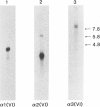Abstract
Type VI collagen is a heterotrimer composed of three polypeptide chains, alpha 1(VI), alpha 2(VI), and alpha 3(VI). By immunological screening of an expression cDNA library, human cDNAs specific for each chain were isolated and characterized. Major mRNA species encoding these chains have a size of 4.2 kb (alpha 1), 3.5 kb (alpha 2), and 8.5 kb (alpha 3). The cDNA clones were also used to map the genes on human chromosomes by somatic cell hybrid analysis and in situ hybridization. The alpha 1 (VI) and alpha 2(VI) collagen genes were both located on chromosome 21, in band q223. This represents a third example of a possible physical proximity of two collagen loci. The alpha 3(VI) collagen gene was localized to chromosome 2, in the region 2q37. The alpha 3(VI) collagen gene is the fifth extracellular matrix gene to be localized to 2q, as four other extracellular matrix genes--i.e., the alpha 1(III) and alpha 2(V) collagen genes, the elastin gene, and the fibronectin gene--have been previously mapped to the distal region of the long arm of chromosome 2.
Full text
PDF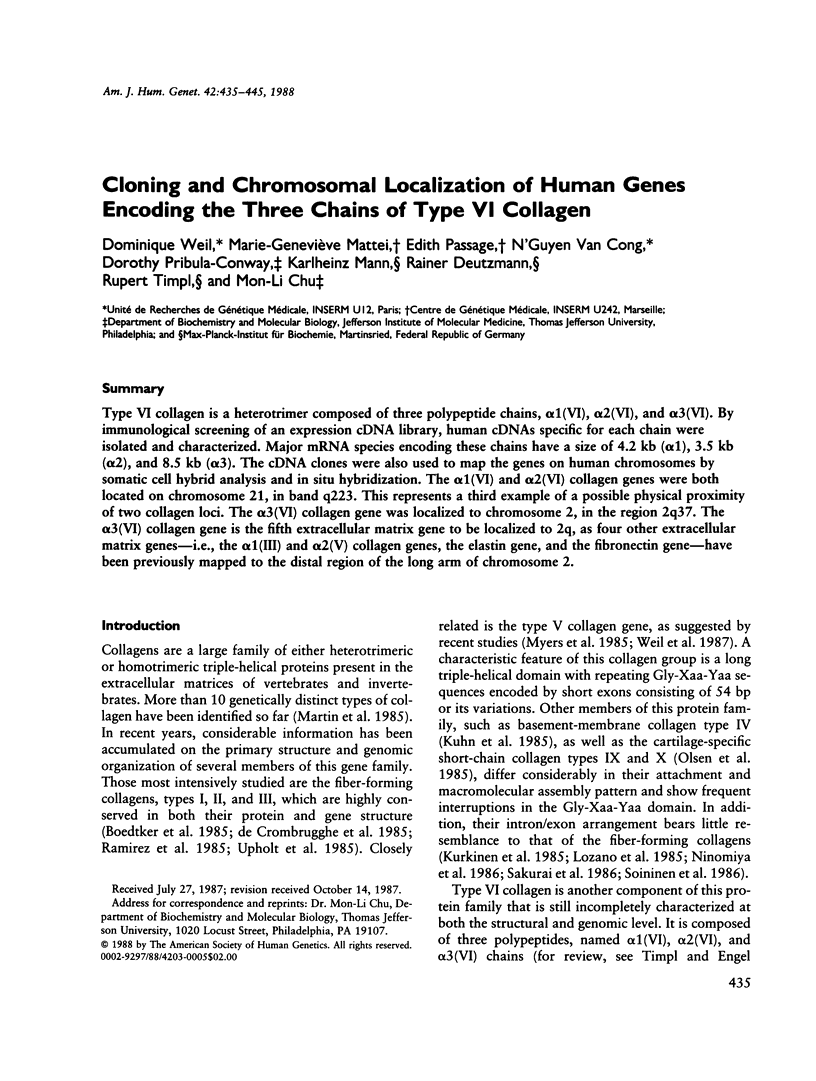
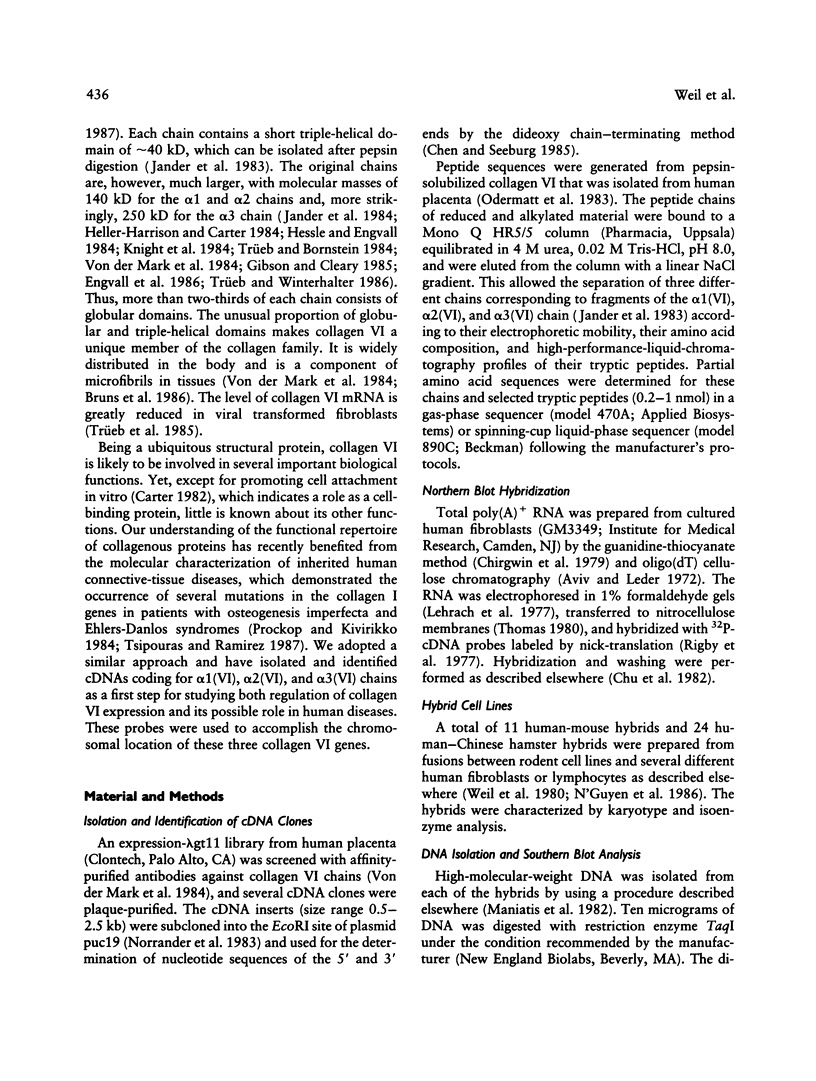
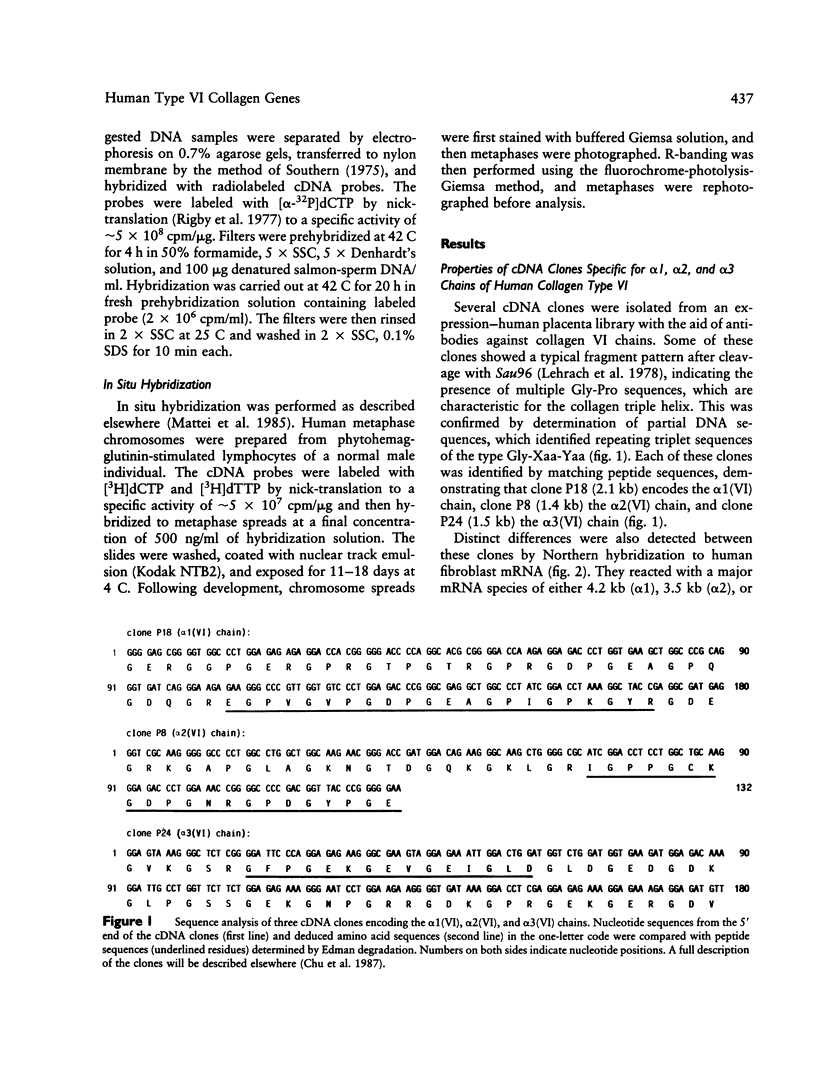
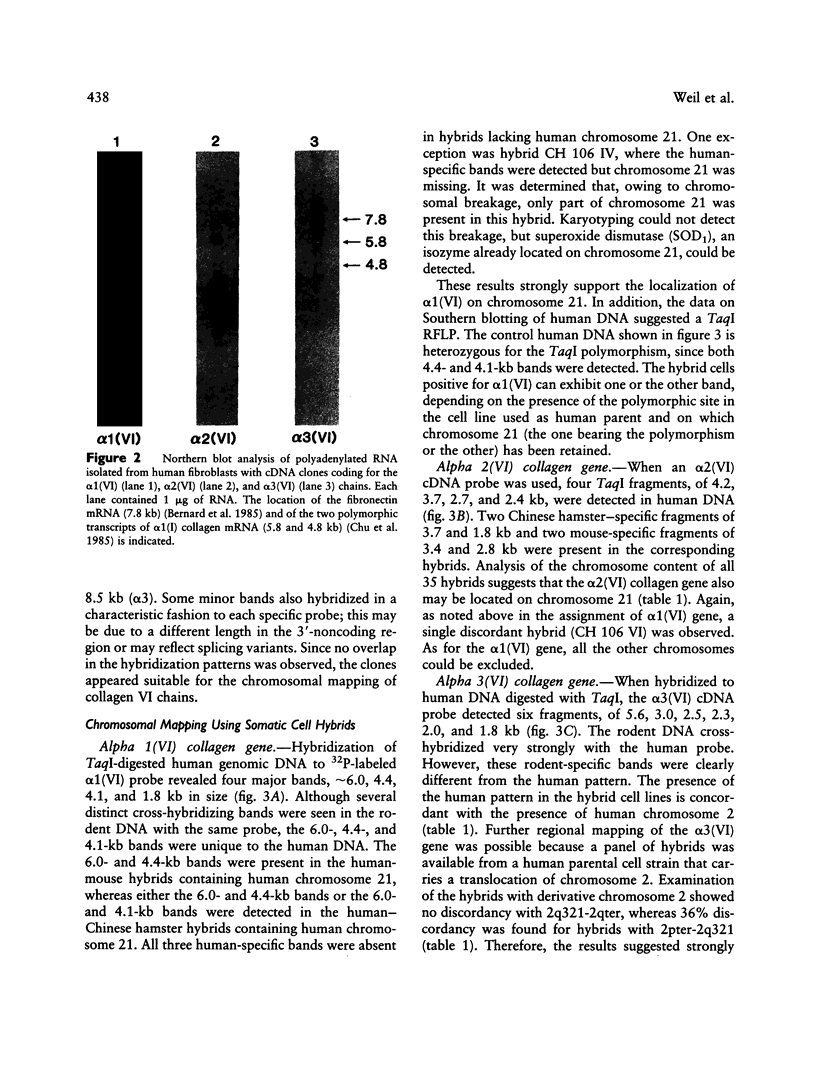
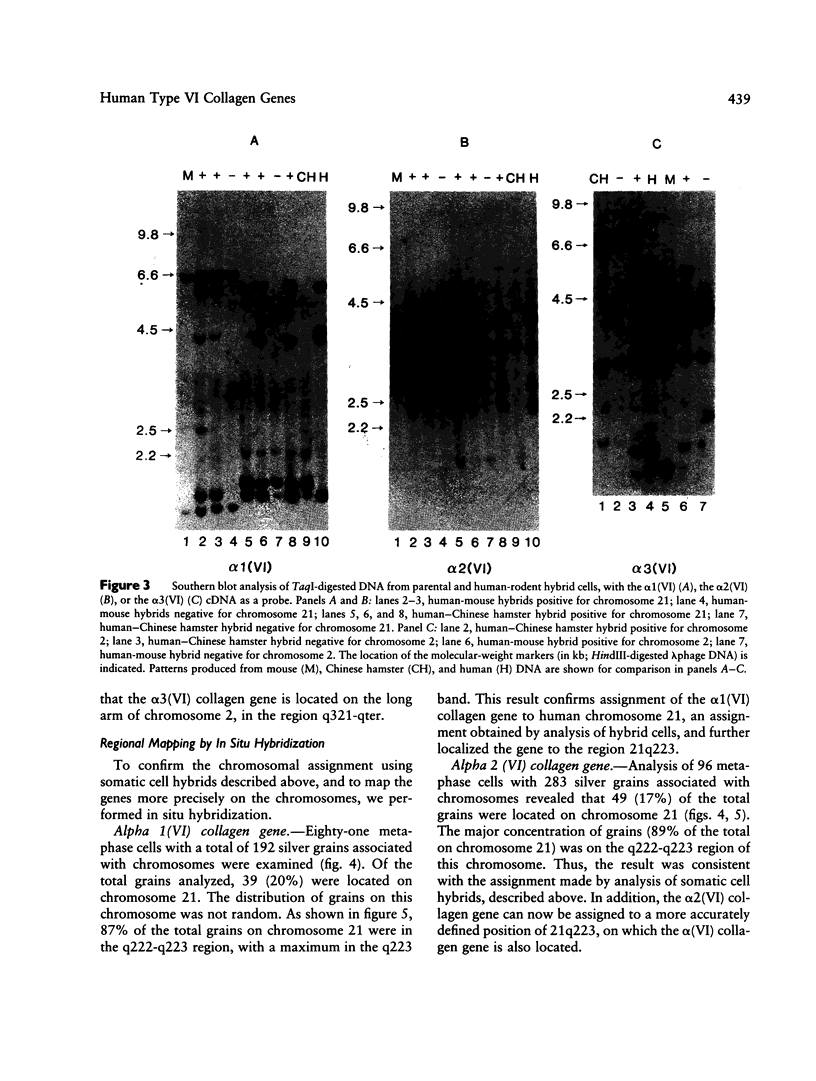
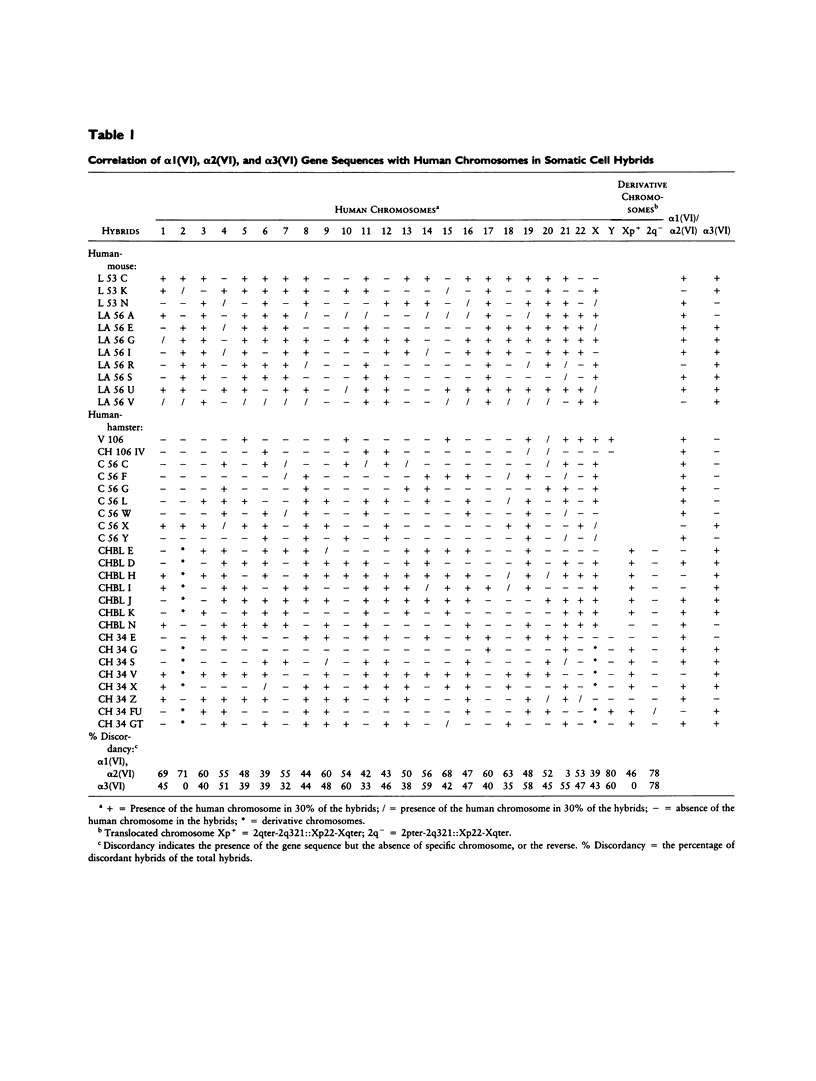
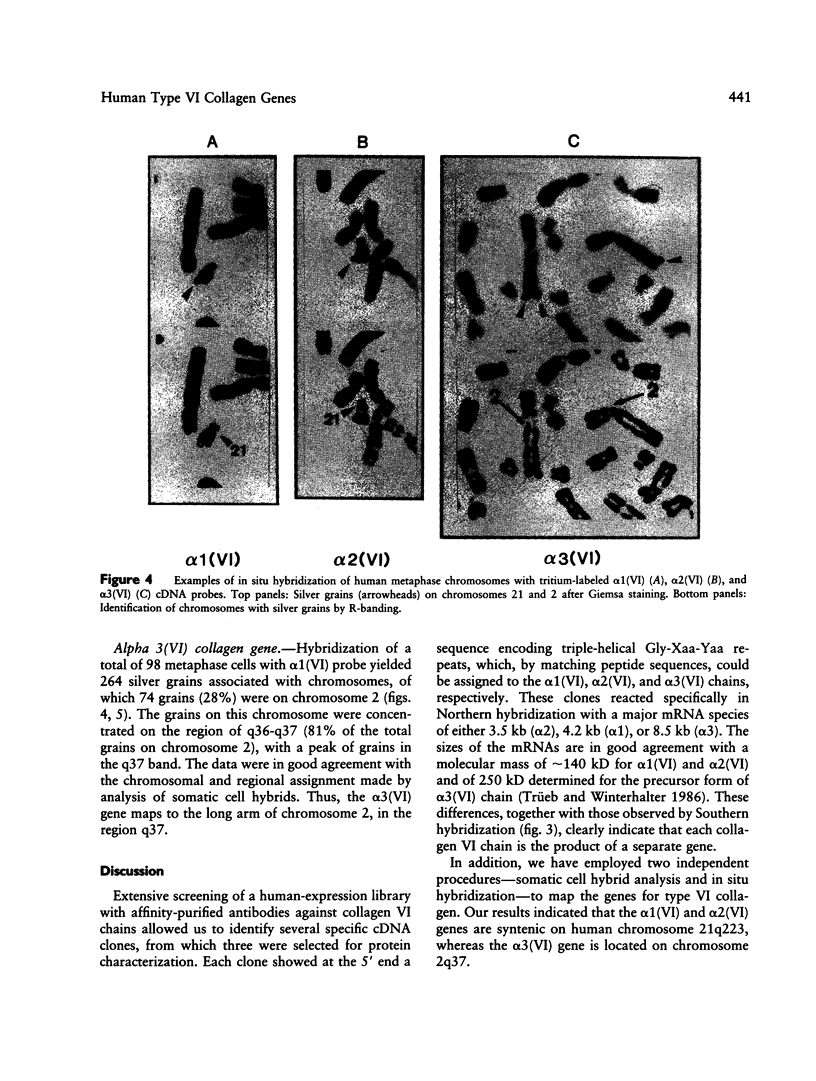
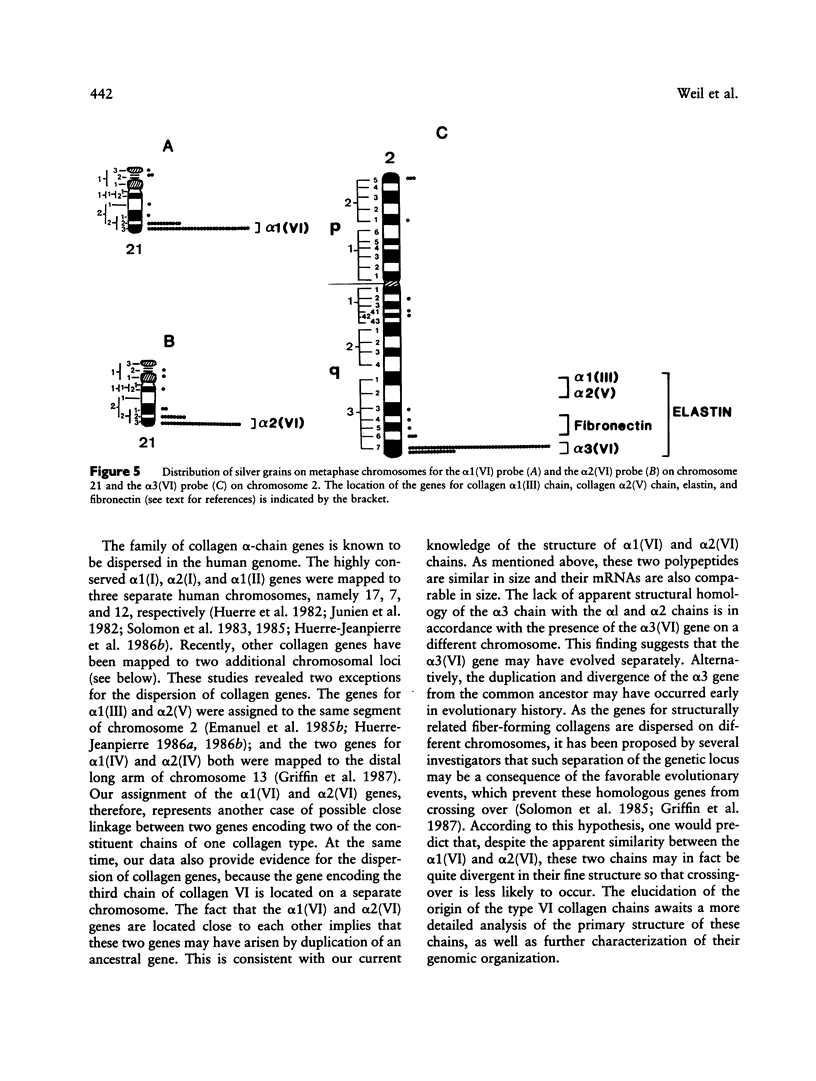
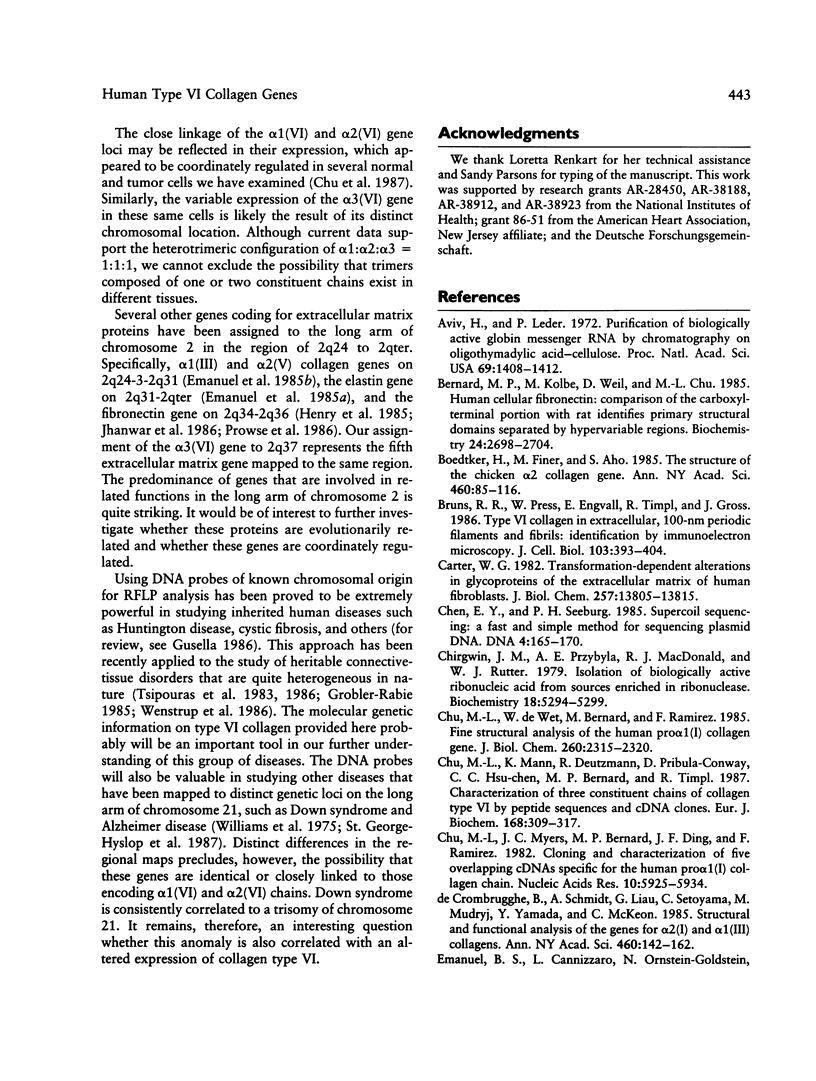
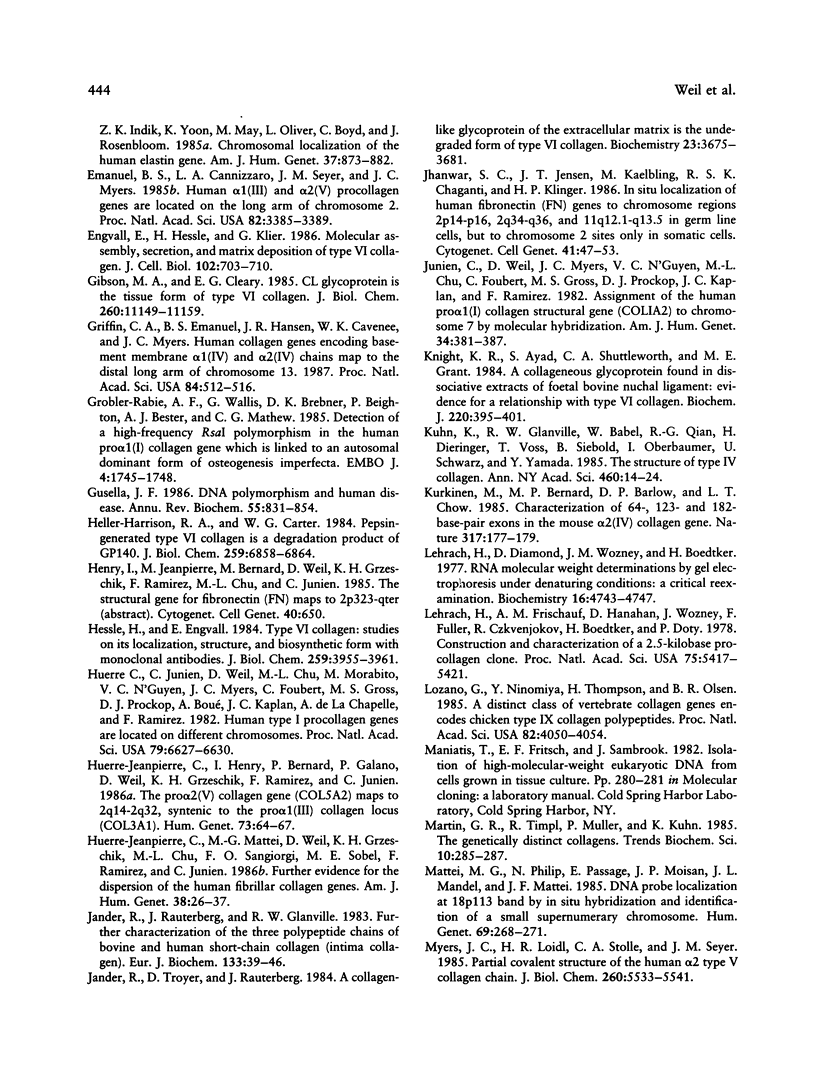
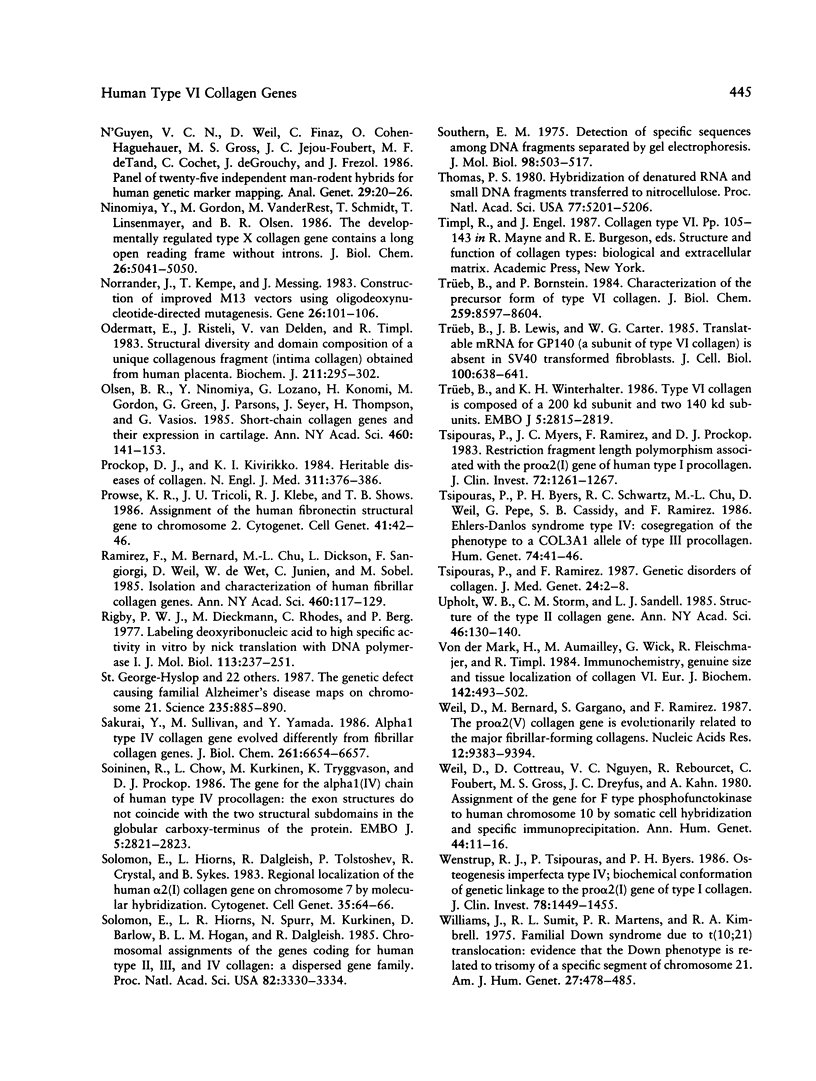
Images in this article
Selected References
These references are in PubMed. This may not be the complete list of references from this article.
- Aviv H., Leder P. Purification of biologically active globin messenger RNA by chromatography on oligothymidylic acid-cellulose. Proc Natl Acad Sci U S A. 1972 Jun;69(6):1408–1412. doi: 10.1073/pnas.69.6.1408. [DOI] [PMC free article] [PubMed] [Google Scholar]
- Bernard M. P., Kolbe M., Weil D., Chu M. L. Human cellular fibronectin: comparison of the carboxyl-terminal portion with rat identifies primary structural domains separated by hypervariable regions. Biochemistry. 1985 May 21;24(11):2698–2704. doi: 10.1021/bi00332a016. [DOI] [PubMed] [Google Scholar]
- Boedtker H., Finer M., Aho S. The structure of the chicken alpha 2 collagen gene. Ann N Y Acad Sci. 1985;460:85–116. doi: 10.1111/j.1749-6632.1985.tb51159.x. [DOI] [PubMed] [Google Scholar]
- Bruns R. R., Press W., Engvall E., Timpl R., Gross J. Type VI collagen in extracellular, 100-nm periodic filaments and fibrils: identification by immunoelectron microscopy. J Cell Biol. 1986 Aug;103(2):393–404. doi: 10.1083/jcb.103.2.393. [DOI] [PMC free article] [PubMed] [Google Scholar]
- Carter W. G. Transformation-dependent alterations is glycoproteins of extracellular matrix of human fibroblasts. Characterization of GP250 and the collagen-like GP140. J Biol Chem. 1982 Nov 25;257(22):13805–13815. [PubMed] [Google Scholar]
- Chen E. Y., Seeburg P. H. Supercoil sequencing: a fast and simple method for sequencing plasmid DNA. DNA. 1985 Apr;4(2):165–170. doi: 10.1089/dna.1985.4.165. [DOI] [PubMed] [Google Scholar]
- Chirgwin J. M., Przybyla A. E., MacDonald R. J., Rutter W. J. Isolation of biologically active ribonucleic acid from sources enriched in ribonuclease. Biochemistry. 1979 Nov 27;18(24):5294–5299. doi: 10.1021/bi00591a005. [DOI] [PubMed] [Google Scholar]
- Chu M. L., Mann K., Deutzmann R., Pribula-Conway D., Hsu-Chen C. C., Bernard M. P., Timpl R. Characterization of three constituent chains of collagen type VI by peptide sequences and cDNA clones. Eur J Biochem. 1987 Oct 15;168(2):309–317. doi: 10.1111/j.1432-1033.1987.tb13422.x. [DOI] [PubMed] [Google Scholar]
- Chu M. L., Myers J. C., Bernard M. P., Ding J. F., Ramirez F. Cloning and characterization of five overlapping cDNAs specific for the human pro alpha 1(I) collagen chain. Nucleic Acids Res. 1982 Oct 11;10(19):5925–5934. doi: 10.1093/nar/10.19.5925. [DOI] [PMC free article] [PubMed] [Google Scholar]
- Chu M. L., de Wet W., Bernard M., Ramirez F. Fine structural analysis of the human pro-alpha 1 (I) collagen gene. Promoter structure, AluI repeats, and polymorphic transcripts. J Biol Chem. 1985 Feb 25;260(4):2315–2320. [PubMed] [Google Scholar]
- Emanuel B. S., Cannizzaro L. A., Seyer J. M., Myers J. C. Human alpha 1(III) and alpha 2(V) procollagen genes are located on the long arm of chromosome 2. Proc Natl Acad Sci U S A. 1985 May;82(10):3385–3389. doi: 10.1073/pnas.82.10.3385. [DOI] [PMC free article] [PubMed] [Google Scholar]
- Emanuel B. S., Cannizzaro L., Ornstein-Goldstein N., Indik Z. K., Yoon K., May M., Oliver L., Boyd C., Rosenbloom J. Chromosomal localization of the human elastin gene. Am J Hum Genet. 1985 Sep;37(5):873–882. [PMC free article] [PubMed] [Google Scholar]
- Engvall E., Hessle H., Klier G. Molecular assembly, secretion, and matrix deposition of type VI collagen. J Cell Biol. 1986 Mar;102(3):703–710. doi: 10.1083/jcb.102.3.703. [DOI] [PMC free article] [PubMed] [Google Scholar]
- Gibson M. A., Cleary E. G. CL glycoprotein is the tissue form of type VI collagen. J Biol Chem. 1985 Sep 15;260(20):11149–11159. [PubMed] [Google Scholar]
- Griffin C. A., Emanuel B. S., Hansen J. R., Cavenee W. K., Myers J. C. Human collagen genes encoding basement membrane alpha 1 (IV) and alpha 2 (IV) chains map to the distal long arm of chromosome 13. Proc Natl Acad Sci U S A. 1987 Jan;84(2):512–516. doi: 10.1073/pnas.84.2.512. [DOI] [PMC free article] [PubMed] [Google Scholar]
- Grobler-Rabie A. F., Wallis G., Brebner D. K., Beighton P., Bester A. J., Mathew C. G. Detection of a high frequency RsaI polymorphism in the human pro alpha 2(I) collagen gene which is linked to an autosomal dominant form of osteogenesis imperfecta. EMBO J. 1985 Jul;4(7):1745–1748. doi: 10.1002/j.1460-2075.1985.tb03845.x. [DOI] [PMC free article] [PubMed] [Google Scholar]
- Gusella J. F. DNA polymorphism and human disease. Annu Rev Biochem. 1986;55:831–854. doi: 10.1146/annurev.bi.55.070186.004151. [DOI] [PubMed] [Google Scholar]
- Heller-Harrison R. A., Carter W. G. Pepsin-generated type VI collagen is a degradation product of GP140. J Biol Chem. 1984 Jun 10;259(11):6858–6864. [PubMed] [Google Scholar]
- Hessle H., Engvall E. Type VI collagen. Studies on its localization, structure, and biosynthetic form with monoclonal antibodies. J Biol Chem. 1984 Mar 25;259(6):3955–3961. [PubMed] [Google Scholar]
- Huerre-Jeanpierre C., Henry I., Bernard M., Gallano P., Weil D., Grzeschik K. H., Ramirez F., Junien C. The pro alpha 2(V) collagen gene (COL5A2) maps to 2q14----2q32, syntenic to the pro alpha 1 (III) collagen locus (COL3A1). Hum Genet. 1986 May;73(1):64–67. doi: 10.1007/BF00292666. [DOI] [PubMed] [Google Scholar]
- Huerre-Jeanpierre C., Mattei M. G., Weil D., Grzeschik K. H., Chu M. L., Sangiorgi F. O., Sobel M. E., Ramirez F., Junien C. Further evidence for the dispersion of the human fibrillar collagen genes. Am J Hum Genet. 1986 Jan;38(1):26–37. [PMC free article] [PubMed] [Google Scholar]
- Huerre C., Junien C., Weil D., Chu M. L., Morabito M., Van Cong N., Myers J. C., Foubert C., Gross M. S., Prockop D. J. Human type I procollagen genes are located on different chromosomes. Proc Natl Acad Sci U S A. 1982 Nov;79(21):6627–6630. doi: 10.1073/pnas.79.21.6627. [DOI] [PMC free article] [PubMed] [Google Scholar]
- Jander R., Rauterberg J., Glanville R. W. Further characterization of the three polypeptide chains of bovine and human short-chain collagen (intima collagen). Eur J Biochem. 1983 Jun 1;133(1):39–46. doi: 10.1111/j.1432-1033.1983.tb07427.x. [DOI] [PubMed] [Google Scholar]
- Jander R., Troyer D., Rauterberg J. A collagen-like glycoprotein of the extracellular matrix is the undegraded form of type VI collagen. Biochemistry. 1984 Jul 31;23(16):3675–3681. doi: 10.1021/bi00311a016. [DOI] [PubMed] [Google Scholar]
- Jhanwar S. C., Jensen J. T., Kaelbling M., Chaganti R. S., Klinger H. P. In situ localization of human fibronectin (FN) genes to chromosome regions 2p14----p16, 2q34----q36, and 11q12.1----q13.5 in germ line cells, but to chromosome 2 sites only in somatic cells. Cytogenet Cell Genet. 1986;41(1):47–53. doi: 10.1159/000132195. [DOI] [PubMed] [Google Scholar]
- Junien C., Weil D., Myers J. C., Van Cong N., Chu M. L., Foubert C., Gross M. S., Prockop D. J., Kaplan J. C., Ramirez F. Assignment of the human pro alpha 2(I) collagen structural gene (COLIA2) to chromosome 7 by molecular hybridization. Am J Hum Genet. 1982 May;34(3):381–387. [PMC free article] [PubMed] [Google Scholar]
- Knight K. R., Ayad S., Shuttleworth C. A., Grant M. E. A collagenous glycoprotein found in dissociative extracts of foetal bovine nuchal ligament. Evidence for a relationship with type VI collagen. Biochem J. 1984 Jun 1;220(2):395–403. doi: 10.1042/bj2200395. [DOI] [PMC free article] [PubMed] [Google Scholar]
- Kurkinen M., Bernard M. P., Barlow D. P., Chow L. T. Characterization of 64-, 123- and 182-base-pair exons in the mouse alpha 2(IV) collagen gene. Nature. 1985 Sep 12;317(6033):177–179. doi: 10.1038/317177a0. [DOI] [PubMed] [Google Scholar]
- Kühn K., Glanville R. W., Babel W., Qian R. Q., Dieringer H., Voss T., Siebold B., Oberbäumer I., Schwarz U., Yamada Y. The structure of type IV collagen. Ann N Y Acad Sci. 1985;460:14–24. doi: 10.1111/j.1749-6632.1985.tb51153.x. [DOI] [PubMed] [Google Scholar]
- Lehrach H., Diamond D., Wozney J. M., Boedtker H. RNA molecular weight determinations by gel electrophoresis under denaturing conditions, a critical reexamination. Biochemistry. 1977 Oct 18;16(21):4743–4751. doi: 10.1021/bi00640a033. [DOI] [PubMed] [Google Scholar]
- Lehrach H., Frischauf A. M., Hanahan D., Wozney J., Fuller F., Crkvenjakov R., Boedtker H., Doty P. Construction and characterization of a 2.5-kilobase procollagen clone. Proc Natl Acad Sci U S A. 1978 Nov;75(11):5417–5421. doi: 10.1073/pnas.75.11.5417. [DOI] [PMC free article] [PubMed] [Google Scholar]
- Lozano G., Ninomiya Y., Thompson H., Olsen B. R. A distinct class of vertebrate collagen genes encodes chicken type IX collagen polypeptides. Proc Natl Acad Sci U S A. 1985 Jun;82(12):4050–4054. doi: 10.1073/pnas.82.12.4050. [DOI] [PMC free article] [PubMed] [Google Scholar]
- Mattei M. G., Philip N., Passage E., Moisan J. P., Mandel J. L., Mattei J. F. DNA probe localization at 18p113 band by in situ hybridization and identification of a small supernumerary chromosome. Hum Genet. 1985;69(3):268–271. doi: 10.1007/BF00293038. [DOI] [PubMed] [Google Scholar]
- Myers J. C., Loidl H. R., Stolle C. A., Seyer J. M. Partial covalent structure of the human alpha 2 type V collagen chain. J Biol Chem. 1985 May 10;260(9):5533–5541. [PubMed] [Google Scholar]
- Nguyen Van Cong, Weil D., Finaz C., Cohen-Haguenauer O., Gross M. S., Jegou-Foubert C., de Tand M. F., Cochet C., de Grouchy J., Frezal J. Panel of twenty-five independent man-rodent hybrids for human genetic marker mapping. Ann Genet. 1986;29(1):20–26. [PubMed] [Google Scholar]
- Ninomiya Y., Gordon M., van der Rest M., Schmid T., Linsenmayer T., Olsen B. R. The developmentally regulated type X collagen gene contains a long open reading frame without introns. J Biol Chem. 1986 Apr 15;261(11):5041–5050. [PubMed] [Google Scholar]
- Norrander J., Kempe T., Messing J. Construction of improved M13 vectors using oligodeoxynucleotide-directed mutagenesis. Gene. 1983 Dec;26(1):101–106. doi: 10.1016/0378-1119(83)90040-9. [DOI] [PubMed] [Google Scholar]
- Odermatt E., Risteli J., van Delden V., Timpl R. Structural diversity and domain composition of a unique collagenous fragment (intima collagen) obtained from human placenta. Biochem J. 1983 May 1;211(2):295–302. doi: 10.1042/bj2110295. [DOI] [PMC free article] [PubMed] [Google Scholar]
- Olsen B. R., Ninomiya Y., Lozano G., Konomi H., Gordon M., Green G., Parsons J., Seyer J., Thompson H., Vasios G. Short-chain collagen genes and their expression in cartilage. Ann N Y Acad Sci. 1985;460:141–153. doi: 10.1111/j.1749-6632.1985.tb51162.x. [DOI] [PubMed] [Google Scholar]
- Prockop D. J., Kivirikko K. I. Heritable diseases of collagen. N Engl J Med. 1984 Aug 9;311(6):376–386. doi: 10.1056/NEJM198408093110606. [DOI] [PubMed] [Google Scholar]
- Prowse K. R., Tricoli J. V., Klebe R. J., Shows T. B. Assignment of the human fibronectin structural gene to chromosome 2. Cytogenet Cell Genet. 1986;41(1):42–46. doi: 10.1159/000132194. [DOI] [PubMed] [Google Scholar]
- Ramirez F., Bernard M., Chu M. L., Dickson L., Sangiorgi F., Weil D., De Wet W., Junien C., Sobel M. Isolation and characterization of the human fibrillar collagen genes. Ann N Y Acad Sci. 1985;460:117–129. doi: 10.1111/j.1749-6632.1985.tb51160.x. [DOI] [PubMed] [Google Scholar]
- Rigby P. W., Dieckmann M., Rhodes C., Berg P. Labeling deoxyribonucleic acid to high specific activity in vitro by nick translation with DNA polymerase I. J Mol Biol. 1977 Jun 15;113(1):237–251. doi: 10.1016/0022-2836(77)90052-3. [DOI] [PubMed] [Google Scholar]
- Sakurai Y., Sullivan M., Yamada Y. Alpha 1 type IV collagen gene evolved differently from fibrillar collagen genes. J Biol Chem. 1986 May 25;261(15):6654–6657. [PubMed] [Google Scholar]
- Soininen R., Chow L., Kurkinen M., Tryggvason K., Prockop D. J. The gene for the alpha 1(IV) chain of human type IV procollagen: the exon structures do not coincide with the two structural subdomains in the globular carboxy-terminus of the protein. EMBO J. 1986 Nov;5(11):2821–2823. doi: 10.1002/j.1460-2075.1986.tb04574.x. [DOI] [PMC free article] [PubMed] [Google Scholar]
- Solomon E., Hiorns L. R., Spurr N., Kurkinen M., Barlow D., Hogan B. L., Dalgleish R. Chromosomal assignments of the genes coding for human types II, III, and IV collagen: a dispersed gene family. Proc Natl Acad Sci U S A. 1985 May;82(10):3330–3334. doi: 10.1073/pnas.82.10.3330. [DOI] [PMC free article] [PubMed] [Google Scholar]
- Solomon E., Hiorns L., Dalgleish R., Tolstoshev P., Crystal R., Sykes B. Regional localization of the human alpha 2(I) collagen gene on chromosome 7 by molecular hybridization. Cytogenet Cell Genet. 1983;35(1):64–66. doi: 10.1159/000131838. [DOI] [PubMed] [Google Scholar]
- Southern E. M. Detection of specific sequences among DNA fragments separated by gel electrophoresis. J Mol Biol. 1975 Nov 5;98(3):503–517. doi: 10.1016/s0022-2836(75)80083-0. [DOI] [PubMed] [Google Scholar]
- St George-Hyslop P. H., Tanzi R. E., Polinsky R. J., Haines J. L., Nee L., Watkins P. C., Myers R. H., Feldman R. G., Pollen D., Drachman D. The genetic defect causing familial Alzheimer's disease maps on chromosome 21. Science. 1987 Feb 20;235(4791):885–890. doi: 10.1126/science.2880399. [DOI] [PubMed] [Google Scholar]
- Thomas P. S. Hybridization of denatured RNA and small DNA fragments transferred to nitrocellulose. Proc Natl Acad Sci U S A. 1980 Sep;77(9):5201–5205. doi: 10.1073/pnas.77.9.5201. [DOI] [PMC free article] [PubMed] [Google Scholar]
- Trüeb B., Bornstein P. Characterization of the precursor form of type VI collagen. J Biol Chem. 1984 Jul 10;259(13):8597–8604. [PubMed] [Google Scholar]
- Trüeb B., Lewis J. B., Carter W. G. Translatable mRNA for GP140 (a subunit of type VI collagen) is absent in SV40 transformed fibroblasts. J Cell Biol. 1985 Feb;100(2):638–641. doi: 10.1083/jcb.100.2.638. [DOI] [PMC free article] [PubMed] [Google Scholar]
- Trüeb B., Winterhalter K. H. Type VI collagen is composed of a 200 kd subunit and two 140 kd subunits. EMBO J. 1986 Nov;5(11):2815–2819. doi: 10.1002/j.1460-2075.1986.tb04573.x. [DOI] [PMC free article] [PubMed] [Google Scholar]
- Tsipouras P., Byers P. H., Schwartz R. C., Chu M. L., Weil D., Pepe G., Cassidy S. B., Ramirez F. Ehlers-Danlos syndrome type IV: cosegregation of the phenotype to a COL3A1 allele of type III procollagen. Hum Genet. 1986 Sep;74(1):41–46. doi: 10.1007/BF00278783. [DOI] [PubMed] [Google Scholar]
- Tsipouras P., Myers J. C., Ramirez F., Prockop D. J. Restriction fragment length polymorphism associated with the pro alpha 2(I) gene of human type I procollagen. Application to a family with an autosomal dominant form of osteogenesis imperfecta. J Clin Invest. 1983 Oct;72(4):1262–1267. doi: 10.1172/JCI111082. [DOI] [PMC free article] [PubMed] [Google Scholar]
- Tsipouras P., Ramirez F. Genetic disorders of collagen. J Med Genet. 1987 Jan;24(1):2–8. doi: 10.1136/jmg.24.1.2. [DOI] [PMC free article] [PubMed] [Google Scholar]
- Upholt W. B., Strom C. M., Sandell L. J. Structure of the type II collagen gene. Ann N Y Acad Sci. 1985;460:130–140. doi: 10.1111/j.1749-6632.1985.tb51161.x. [DOI] [PubMed] [Google Scholar]
- Weil D., Cottreau D., Nguyen Van Cong, Rebourcet R., Foubert C., Gross M. S., Dreyfus J. C., Kahn A. Assignment of the gene for F-type phosphofructokinase to human chromosome 10 by somatic cell hybridization and specific immunoprecipitation. Ann Hum Genet. 1980 Jul;44(Pt 1):11–16. doi: 10.1111/j.1469-1809.1980.tb00941.x. [DOI] [PubMed] [Google Scholar]
- Wenstrup R. J., Tsipouras P., Byers P. H. Osteogenesis imperfecta type IV. Biochemical confirmation of genetic linkage to the pro alpha 2(I) gene of type I collagen. J Clin Invest. 1986 Dec;78(6):1449–1455. doi: 10.1172/JCI112735. [DOI] [PMC free article] [PubMed] [Google Scholar]
- Williams J. D., Summitt R. L., Martens P. R., Kimbrell R. A. Familial Down syndrome due to t(10;21) translocation: evidence that the Down phenotype is related to trisomy of a specific segment of chromosome 21. Am J Hum Genet. 1975 Jul;27(4):478–485. [PMC free article] [PubMed] [Google Scholar]
- de Crombrugghe B., Schmidt A., Liau G., Setoyama C., Mudryj M., Yamada Y., McKeon C. Structural and functional analysis of the genes for alpha 2(I) and alpha 1(III) collagens. Ann N Y Acad Sci. 1985;460:154–162. doi: 10.1111/j.1749-6632.1985.tb51163.x. [DOI] [PubMed] [Google Scholar]
- von der Mark H., Aumailley M., Wick G., Fleischmajer R., Timpl R. Immunochemistry, genuine size and tissue localization of collagen VI. Eur J Biochem. 1984 Aug 1;142(3):493–502. doi: 10.1111/j.1432-1033.1984.tb08313.x. [DOI] [PubMed] [Google Scholar]



